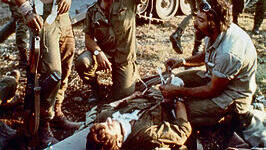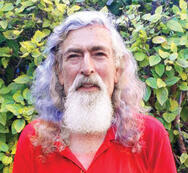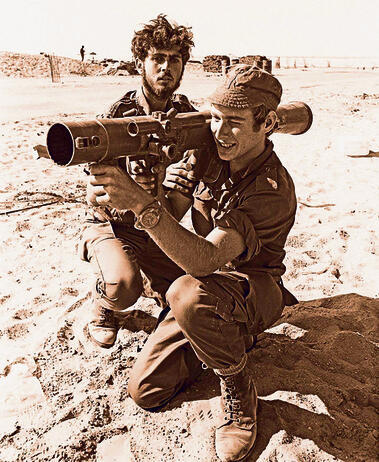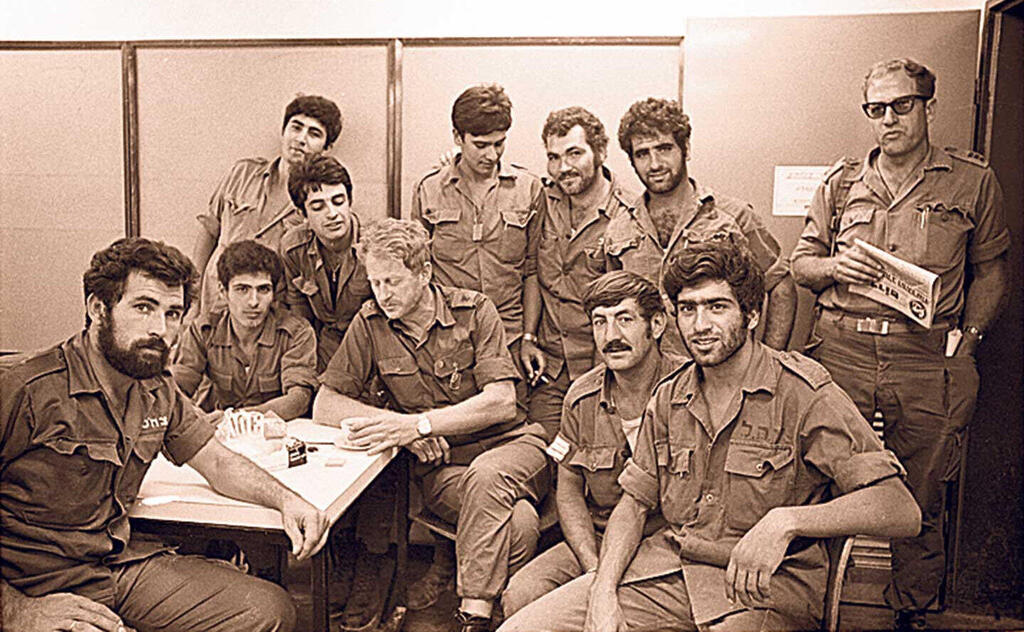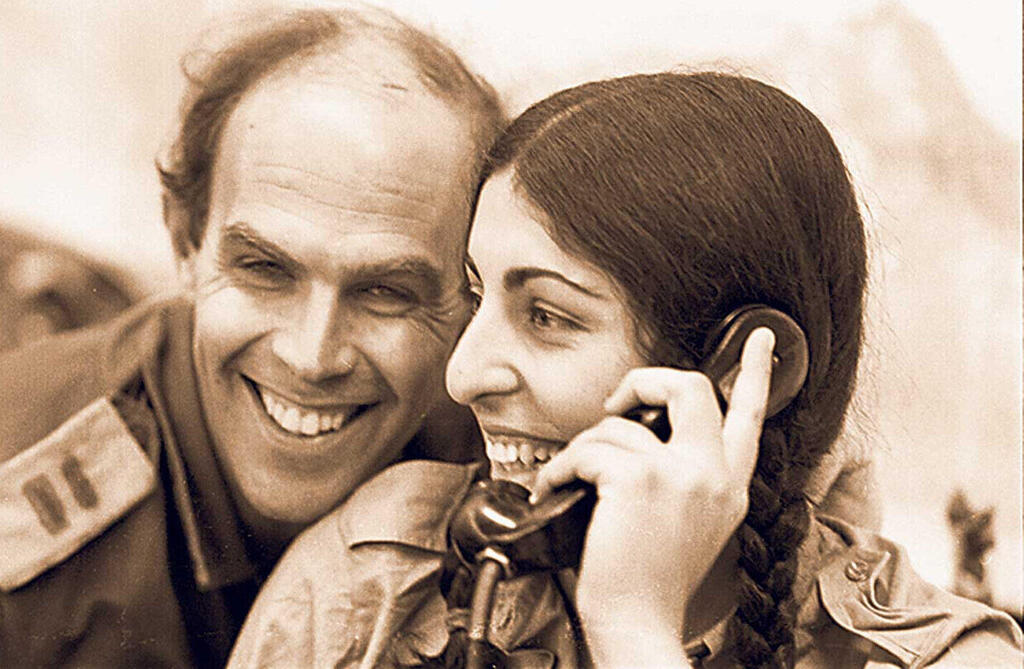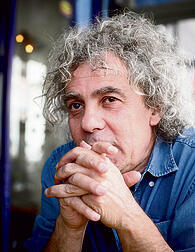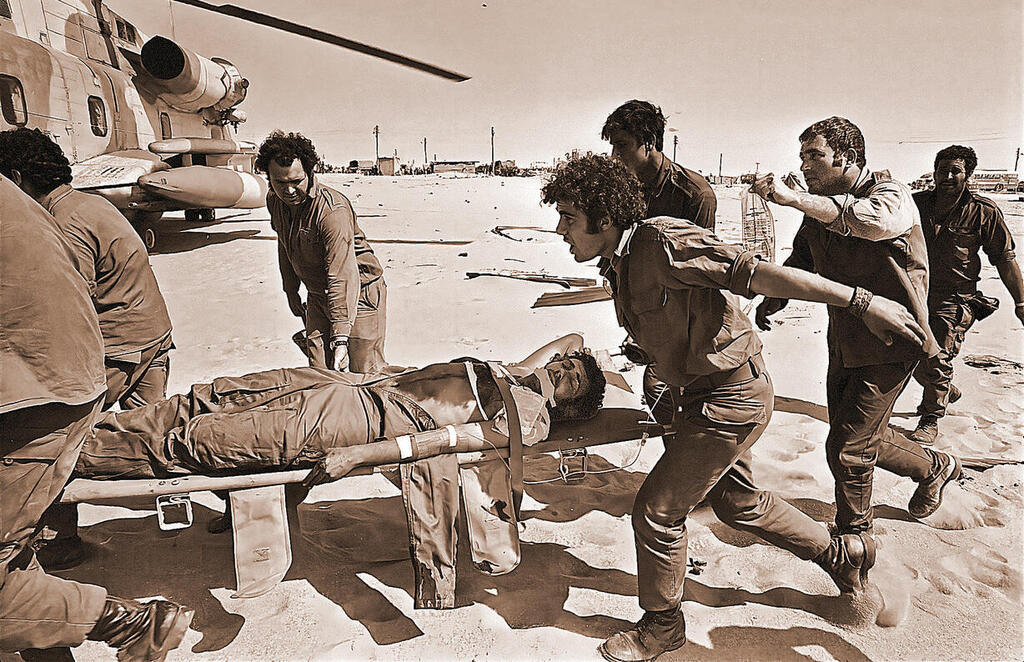Pini Almog
"When the war broke out, I was 26 years old and serving as a medic in the 32nd Battalion of the Alexandroni Brigade. On Yom Kippur, I found myself trapped at my residence in Kfar Blum (A Kibbutz on the northern tip of Israel)," recalls Pini Almog, who is now 76 years old. "There's a photo of me taken near Outpost 116, where we were surrounded by Syrian forces. Despite the intense shelling, our primary focus was on rescuing and treating the wounded fighters.
Read more:
"In the picture, you can see me with a beard and sunglasses, kneeling beside a military stretcher as I administer an infusion into a soldier's vein. Thankfully, the wounded man in the photo survived, but we faced incredibly challenging situations there. We encountered wounded individuals without arms or legs, and I distinctly remember personally handling someone's intestines."
Pini Almog, who is married to Anati and has three children and nine grandchildren, currently resides in Kiryat Tivon and is involved in tourism and sailing. Reflecting on the past, he shares, "I was unaware of this photograph until several years later when neighbors pointed it out to me in a color brochure." Despite the passage of 50 years, Almog vividly remembers the initial moments of the war. "As soon as we heard the Syrian planes flying overhead, we knew something was wrong. At that time, our kibbutz had Renault 5 cars, and we used them to travel from Mount Golan, which is on the Syrian border, to evacuate all the children from there to the nearby kibbutz of Mahanayim."
"Around 18:00, we assembled near the Mahanayim airport," he reminisces. "Little did we know, it was a grave error, as the Syrians attempted to shell the airport, resulting in the tragic loss of one of our fellow soldiers. I can still hear the voice of Brigade chief Yanush Ben-Gal, urging us to take action, 'Move, let the tanks advance.' It was a relentless and arduous battle. The Syrians launched a fierce attack, leading to some of our comrades being captured, while we diligently worked to gather and tend to the wounded."
Moti Itzkovich and Shaike Ben-Gal
Moti Itzkovich, a 69-year-old father of three and grandfather of six from Petach-Tikva, reflects on his military service, stating, "I was conscripted in '72, and at that time, I had no fear of war. Who could have anticipated that there would be a war? Even the generals didn't anticipate it, so why would I? There was a sense of euphoria following the six-day conflict, and our service up until the outbreak of war was considered easy-going." Itzkovich shares this as he is captured in a photograph, holding a rocket on his shoulder.
"We held a position along the Suez Canal, so my memories resemble those of a camp. We conducted patrols along the canal, occasionally stopping to enjoy a picnic along the way, and even exchanged waves with the Egyptian soldiers on the opposite side," he recalls. "This particular photo, where I am the soldier on the right, was taken after the war on the western side of the canal. It was a period of waiting before the ceasefire took effect. The Americans sent an air convoy of ammunition, and what you see in the picture is a portion of it - an anti-tank shoulder missile, similar to an RPG but more advanced. In the photo, I am holding and aiming the rocket launcher as part of our training."
The second person captured in the photograph is Shaike Ben-Gal, also 69 years old, a father of four and a proud grandfather. He grew up in Zichron Ya'akov and currently resides in Moshav HaZor'im in the Lower Galilee, where he oversees a high school dedicated to environmental education. Following the war, Shaike served in the armor school. "We were assigned to Haim Erez's brigade," he reflects. "However, one platoon remained behind to ensure the safe transport of the Galilee bridge, along a crucial axis, to be placed in the canal. The entire company crossed the canal, and as one of its soldiers, I was among those who stayed to secure the tank company. Eventually, we all regrouped. I don't recall much about the specific photo, but I believe I did nothing out of the ordinary during the war. I simply did what was necessary."
Yisrael Finkelstein
The one who identified the photo of the late Yisrael Finkelstein was actually his aunt, who promptly got in touch with his children - Sharona, Dafna, Boaz, and Yifat. "This is a photo we were unfamiliar with. And since we saw it, we haven't been able to contain our excitement," shares Yifat, one of his daughters. "Seeing our dad suddenly was an incredibly thrilling experience. We can't help but keep gazing at the picture. When we searched for any mention of the war anniversary on various platforms, we came up empty-handed, and then this photo appeared like a message from him. We are certain that he would have been deeply moved by the picture, and perhaps he would have shared some stories about the harrowing war with us."
Yisrael passed away in 2004, when he was 70 years old. His wife, Tamar, recently passed away just a few months ago at the age of 81. "Father was called up on the very first day of the war," recalls Sharona, the eldest daughter who was eight years old at the time. "He returned from the synagogue, dressed in white, and immediately left for the army. There wasn't any special farewell. We believe he likely served as a driver during the war, as in the First Lebanon War, when I was older, he used to drive soldiers into Lebanon and would bring us cherries. However, from the photo that was published, I don't recognize anyone."
Tzvika Levana
During the Six Day War, I was a student who had received a deferment from military service. I was married and had a three-month-old daughter at the time, and truthfully, I didn't actively participate in the war. It left me feeling incredibly frustrated. On Yom Kippur, I was at home when the alarm sounded at two in the afternoon. I remember thinking to myself, "Just don't stay home." These words come from Tzvika Levana, an 82-year-old resident of Lehavim, a town in southern Israel. Tzvika is married to Nurit, a father of three, and a proud grandfather of ten. He holds a doctorate in materials and dedicated 42 years of his life working at the nuclear research center in Dimona.
"During that time, I was part of the Southern Command, although I didn't belong to a specific unit. As soon as I received the alarm, I made my way to the command center in Be'er Sheva, where I remained for a duration of five months," he reminisces. "Just two days after the war broke out, we were transported by helicopter to the central headquarters of the Southern Command in the Sinai. It was an expansive headquarters bustling with soldiers. The renowned Gorodish (Shmuel "Gorodish" Gonen, an Israeli general and Chief of the Southern Command of the IDF during the Yom Kippur War) was present as well. Everything that you may have heard about occurred there, and the experiences were even more extensive than can be described."
Rino Tzror
After the photo was published in Yedioth Ahronoth, the photojournalist Shabtai Tal, who had captured the image during the fourth day of the war at the base in North Sinai, couldn't identify the individuals depicted carrying the wounded man. However, this week, journalist Rino Tzrur, who recreated the event, recognized himself in the photo. He explained, "Two months before the war, I had been discharged from the paratroopers corps and joined 'Ha'olam Hazeh' (a defunct newspaper). Alongside me was a talented and gracious photographer named Rami Halperin. Editor Eli Tavor brought us together, forming a daring team of newcomers who were ready to go wherever we were assigned."
"During the second day of the war, Rami and I made a decision to head towards the southern front, as that's where his comrades from Battalion 184 were stationed," he explains. "They were positioned within the base along the canal, and they were the ones facing the initial impact. When we arrived there, we made a conscious choice to don uniforms instead of our usual attire as journalists or military correspondents. We wanted to be seen as fighters, not just observers. So, we joined the ranks and ventured down to the south."
He reflects on the photo, describing it as capturing a moment during their initial hour in the war: "In that moment, we comprehended the enormity of the breach, not through words but through witnessing it with our own eyes. A swarm of helicopters hovered above, while on the ground, there were countless stretchers carrying wounded individuals in various states. It became apparent to us that there was a shortage of people available to carry these stretchers."
"When carrying a stretcher, it's crucial for those at the front and back to align themselves properly to maintain balance," he elaborates. "If you examine the picture closely, you'll notice that I take a massive stride and shout, most likely urging others to move quickly. I must have yelled, 'hurry, hurry' as I pushed forward, which reflects the chaotic environment I found myself in.
"On October 18, twelve days after the photo was captured, Rami tragically lost his life due to a bullet piercing his heart. I was unaware of the existence of the photo until now. Once I was identified in the image, I promptly reached out to Shabtai, the photographer, and meticulously examined each frame with him, hoping to find traces of Rami as well. However, it seems that he was likely carrying a stretcher in the opposite direction, while Shabtai's focus was on me and the path ahead. Only longing remains."
WHERE ISRAEL STANDS NOW 50 YEARS ON - AMIR AVIVI
(ILTV)


